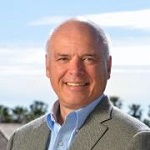Understanding and Exploiting Complex and Self-Configuring Photonics
Hosted By: Nanophotonics Technical Group
07 June 2022 19:00 - 20:00
Eastern Time (US & Canada) (UTC -05:00)Current and emerging micro- and nano-fabrication enable very sophisticated and complex optical circuits and nanophotonic elements. Already, we understand that such nanophotonics can make very compact components. Recent work in meshes of silicon photonic interferometers shows such complex and programmable circuits can go well beyond previous optical functions. Potential applications include communications, allowing large numbers of overlapping and changing channels; information processing, such as arbitrary low-power quantum and classical matrix operations and neural network circuits; and sensing, including automatic coupling, filtering and real-time adaptation. These circuits can implement any linear transform and can also be self-configured and self-stabilized, even without any calculations.
Such work exposes new concepts in optical architectures, topologies, and algorithms, opening a new class of optics. This kind of optics is so different that we need new ways of thinking, well beyond lenses, mirrors, rays, and even beams. Fortunately, there is a surprisingly simple new “modal” approach that is universal and quite fundamental, which matches very well to these new circuits and to novel nanophotonics. It exposes new physical laws and limits, while connecting to the emerging complex architectures exposed by these ideas. This new approach in optics and nanophotonics therefore opens a wide range of quite radical possibilities in structures and circuits we can actually make.
Subject Matter Level: Intermediate - Assumes basic knowledge of the topic
What You Will Learn:
- A new way of understanding and constructing arbitrary optics based on interferometric circuits
- A new “modal” approach that is universal and quite fundamental for designing complex optical circuits and nanophotonic elements.
- The wide range of quite radical possibilities that such a "modal" approach opens in structures and circuits we can make.
Who You Should Attend:
- Students
- Researchers
- Engineers
About the Presenter: David A.B. Miller, Stanford University
 David Miller (B. Sc., St. Andrews University, Ph. D, Heriot-Watt University) is the W. M. Keck Professor of Electrical Engineering at Stanford University, and Professor by Courtesy of Applied Physics. Before moving to Stanford in 1996, he was a department head at Bell Laboratories. His interests include nanophotonics, quantum-well optoelectronics, and optics in information sensing, interconnects, and processing. He has published > 280 scientific papers, a quantum mechanics text, and > 75 patents, and has a Google h-index > 100. He has taught open online quantum mechanics classes to > 50,000 students. He was President of IEEE LEOS (now Photonics Society) in 1995. His awards include the OSA Adolph Lomb Medal and R. W. Wood Prize, and the ICO International Prize in Optics. He is a Fellow of APS, OSA, IEEE, the Electromagnetics Academy, the Royal Societies of London and Edinburgh, holds two Honorary Doctorates, and is a Member of the US National Academies of Sciences and of Engineering.
David Miller (B. Sc., St. Andrews University, Ph. D, Heriot-Watt University) is the W. M. Keck Professor of Electrical Engineering at Stanford University, and Professor by Courtesy of Applied Physics. Before moving to Stanford in 1996, he was a department head at Bell Laboratories. His interests include nanophotonics, quantum-well optoelectronics, and optics in information sensing, interconnects, and processing. He has published > 280 scientific papers, a quantum mechanics text, and > 75 patents, and has a Google h-index > 100. He has taught open online quantum mechanics classes to > 50,000 students. He was President of IEEE LEOS (now Photonics Society) in 1995. His awards include the OSA Adolph Lomb Medal and R. W. Wood Prize, and the ICO International Prize in Optics. He is a Fellow of APS, OSA, IEEE, the Electromagnetics Academy, the Royal Societies of London and Edinburgh, holds two Honorary Doctorates, and is a Member of the US National Academies of Sciences and of Engineering.
